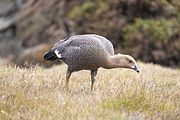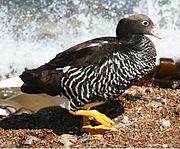Genus of birds
| Sheldgoose | |
|---|---|
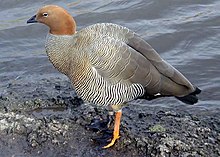
| |
| Ruddy-headed goose, Chloephaga rubidiceps | |
| Scientific classification | |
| Domain: | Eukaryota |
| Kingdom: | Animalia |
| Phylum: | Chordata |
| Class: | Aves |
| Order: | Anseriformes |
| Family: | Anatidae |
| Subfamily: | Tadorninae |
| Genus: | Chloephaga Eyton, 1838 |
| Type species | |
| Anas magellanica = Anas leucoptera Gmelin, JF 1789 | |
| Species | |
Chloephaga is a genus of sheldgeese in the family Anatidae. Other sheldgeese are found in the genera Alopochen and Neochen.
Taxonomy
The genus Chloephaga was introduced in 1838 by the English naturalist Thomas Campbell Eyton in his A Monograph on the Anatidae, or Duck Tribe. He designated the type species as Chloephaga magellanica. This is Anas magellanica Gmelin, JF 1789, which is a synonym of Anas leucoptera Gmelin, JF 1789. Anas leucoptera is now considered as a subspecies of the upland goose Chloephaga picta leucoptera. The genus name comes from the combination of the Ancient Greek khloē meaning "grass" with -phagos meaning "-eating".
A molecular phylogenetic study by Mariana Bulgarella and collaborators published in 2014 found that the Orinoco goose in the monotypic genus Neochem, was embedded in the genus Chloephaga:
| |||||||||||||||||||||||||||||||
Based on this result, some authorities place the Orinoco goose together with the Andean goose in the resurrected genus Oressochen.
A fossilized partial coracoid (CTES-PZ 7797) of an indeterminate Chloephaga species sharing some characters with the extant upland goose is known from the upper Pleistocene Toropí Formation (also called the Yupoí Formation) in Corrientes Province, Argentina, 700 kilometers further north than the northernmost present-day record of the genus.
Species
The genus contains five species.
| Common name | Scientific name and subspecies | Range | Size and ecology | IUCN status and estimated population |
|---|---|---|---|---|
| Andean goose | Chloephaga melanoptera (Eyton, 1838) |
Peru to south Chile and Argentina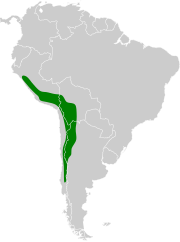
|
Size: Habitat: Diet: |
LC
|
| Upland goose or Magellan goose | Chloephaga picta (Gmelin,, 1789) two subspecies
|
southernmost South America
|
Size: Habitat: Diet: |
LC
|
| Kelp goose | Chloephaga hybrida (Molina, 1782) two subspecies
|
Chile's southern half to the eastern tip of Tierra del Fuego and the Falkland Islands
|
Size: Habitat: Diet: |
LC
|
| Ashy-headed goose | Chloephaga poliocephala P.L. Sclater, 1857 |
southernmost South America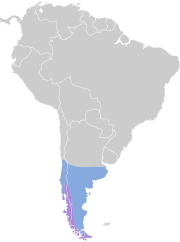
|
Size: Habitat: Diet: |
LC
|
| Ruddy-headed goose | Chloephaga rubidiceps Sclater, PL, 1861 |
Tierra del Fuego, Chile and the Falkland Islands and southern Argentina
|
Size: Habitat: Diet: |
LC
|
See also
- List of extinct bird species since 1500
- List of Late Quaternary prehistoric bird species
- List of fossil bird genera
References
- "Anatidae". aviansystematics.org. The Trust for Avian Systematics. Retrieved 5 August 2023.
- Eyton, Thomas Campbell (1838). A Monograph on the Anatidae, or Duck Tribe. London: Longman, Orme, Brown, Green, & Longman. p. 13.
- Mayr, Ernst; Cottrell, G. William, eds. (1979). Check-List of Birds of the World. Vol. 1 (2nd ed.). Cambridge, Massachusetts: Museum of Comparative Zoology. p. 447.
- Jobling, James A. (2010). The Helm Dictionary of Scientific Bird Names. London: Christopher Helm. p. 102. ISBN 978-1-4081-2501-4.
- Bulgarella, M.; Kopuchian, C.; Giacomo, A.S.D.; Matus, R.; Blank, O.; Wilson, R.E.; Mccracken, K.G. (2014). "Molecular phylogeny of the South American sheldgeese with implications for conservation of Falkland Islands (Malvinas) and continental populations of the Ruddy-headed Goose Chloephaga rubidiceps and Upland Goose C. picta". Bird Conservation International. 24 (1): 59–71. doi:10.1017/S0959270913000178. hdl:11336/25659.
- Jaramillo, Alvaro (July 2014). "Proposal 637: Treat Chloephaga melanoptera and Neochen jubata as congeners". South American Classification Committee, American Ornithologists' Union. Retrieved 2 July 2022.
- Davenport, L.; Endo, W.; Kriese, K. (2020). Schulenberg, T.S. (ed.). "Orinoco Goose (Oressochen jubatus), version 1.0". Birds of the World. Ithaca, NY, USA: Cornell Lab of Ornithology. doi:10.2173/bow.origoo1.01. S2CID 216415094. Retrieved 2 July 2022.
- Duvall, A. (2020). Schulenberg, T.S. (ed.). "Andean Goose (Oressochen melanopterus), version 1.0". Birds of the World. Ithaca, NY, USA: Cornell Lab of Ornithology. doi:10.2173/bow.andgoo1.01. Retrieved 2 July 2022.
- Álvarez-Herrera, Gerardo P.; Agnolín, Federico L.; Méndez, Cecilia; Luna, Carlos; Cuaranta, Pedro; Contreras, Silvina; Zurita, Alfredo E. (19 August 2022). "The Northernmost record of the goose genus Chloephaga (Eyton, 1838) (Aves, Anatidae) and its biogeographical implications". Journal of South American Earth Sciences. 119: 103988. Bibcode:2022JSAES.11903988A. doi:10.1016/j.jsames.2022.103988. ISSN 0895-9811. S2CID 251705841.
- Gill, Frank; Donsker, David; Rasmussen, Pamela, eds. (January 2022). "Screamers, ducks, geese & swans". IOC World Bird List Version 12.1. International Ornithologists' Union. Retrieved 2 July 2022.
External links
- [REDACTED] Data related to Chloephaga at Wikispecies
- [REDACTED] Media related to Chloephaga at Wikimedia Commons
| Genera of waterfowl and their extinct allies | |||||||||||||||||||||||||||||||||||||||
|---|---|---|---|---|---|---|---|---|---|---|---|---|---|---|---|---|---|---|---|---|---|---|---|---|---|---|---|---|---|---|---|---|---|---|---|---|---|---|---|
| |||||||||||||||||||||||||||||||||||||||
| |||||||||||||||||||||||||||||||||||||||
| Taxon identifiers | |
|---|---|
| Chloephaga | |


